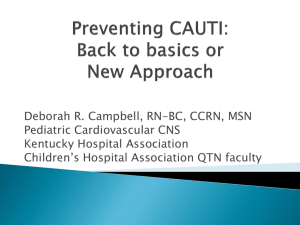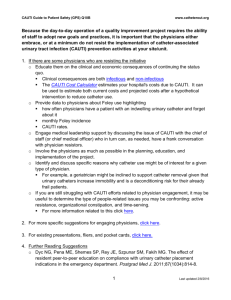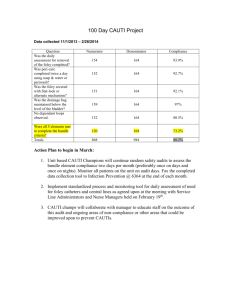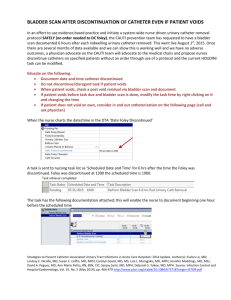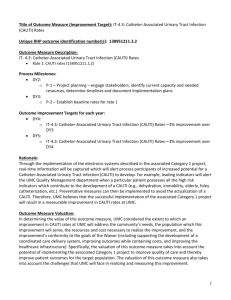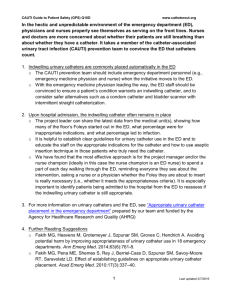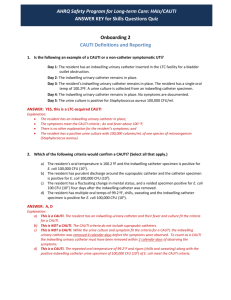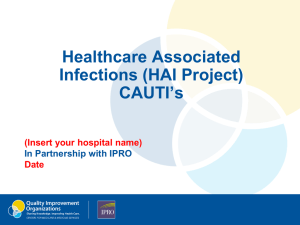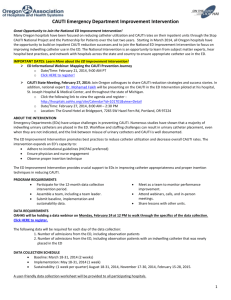C3 Onboarding Webinar #2 PPT Slides
advertisement
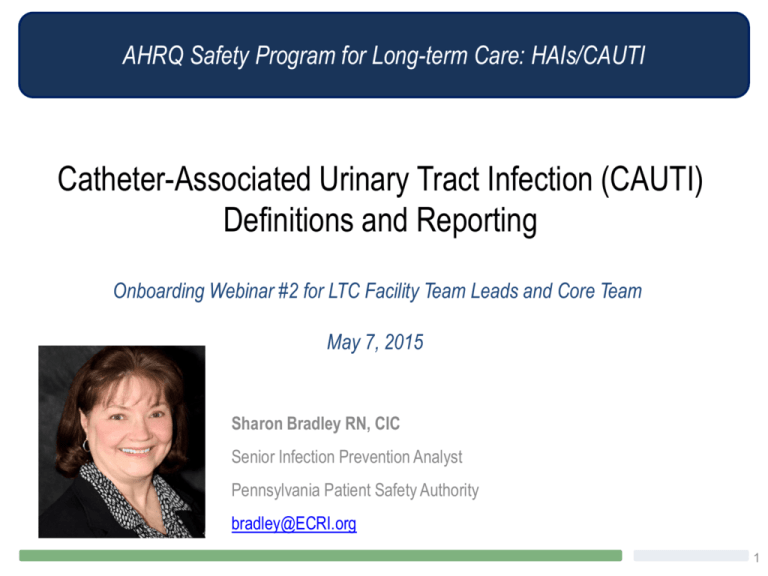
AHRQ Safety Program for Long-term Care: HAIs/CAUTI Catheter-Associated Urinary Tract Infection (CAUTI) Definitions and Reporting Onboarding Webinar #2 for LTC Facility Team Leads and Core Team May 7, 2015 Sharon Bradley RN, CIC Senior Infection Prevention Analyst Pennsylvania Patient Safety Authority bradley@ECRI.org 1 Learning Objectives Upon completion of the webinar, core team members will be able to: • demonstrate a working knowledge of the signs, symptoms, and lab tests appropriate for diagnosing a CAUTI using the NHSN criteria; • use the train-the-trainer materials to cascade content to facility frontline staff; • provide specific examples of how every team member can help reduce healthcare-associated infections and provide safe care; and • understand the importance of their role in connecting CAUTI identification to their facility’s overall safety plan for residents and staff. 2 What is a Catheter-Associated Urinary Tract Infection (CAUTI)? An infection occurs when a resident with an indwelling urinary catheter: • Manifests one or more symptoms localized to the urinary tract AND • Symptoms have no alternative source AND • Clinical signs and symptoms are combined with laboratory verification of an infection NHSN LTC 3 Finding a CAUTI—4 Easy Questions to Ask Four Questions to Identify a CAUTI Question 1 Question 2 Question 3 Question 4 Does the resident have an indwelling urinary catheter connected to a drainage device? Does the resident have one or more CAUTI symptoms? There is no other explanation for this resident’s symptoms? Does the resident have a urine culture that fits the criteria? YES YES YES YES then the resident has a CAUTI! 4 Why Focus on Reducing and Preventing CAUTIs? • Increases morbidity and mortality • Increases resident and family suffering • Cystitis, pyelonephritis, bacteremia and septic shock • Decline in resident function and mobility • Acute-care hospitalizations and re-hospitalization • Increased risk of colonization/infections with MDROs • Inappropriate antimicrobial use • Operational costs of increased care and treatment Healthcare Infection Control Practices Advisory Committee 5 Question 1: What is an Indwelling Urinary Catheter? An Indwelling Urinary Catheter IS: An Indwelling Urinary Catheter is NOT: • a drainage tube inserted into the urinary bladder through the urethra; • an in-and-out catheter; • left in place and connected to a closed collection system; and • a suprapubic catheter, nor • a nephrostomy tube. • sometimes called a “Foley” catheter. 6 Question 1: Increased Risk of Infection with an Indwelling Urinary Catheter4 Indwelling Urinary Catheter Photograph from NHSN LTC Scanning electron micrograph of S. aureus bacteria on the luminal surface of an indwelling catheter known as a biofilm. Photograph from CDC Public Health Image Library. ID number 7488. Photograph by Janice Haney Carr in 2005. Accessible: http://phil.cdc.gov/phil/details.asp 7 Question 1: Recent Catheter Removal and CAUTI If the indwelling urinary catheter was removed within 2 calendar days prior to the development of CAUTI signs and symptoms, then it’s a CAUTI as long as the urine culture criteria is met • Day of catheter removal = day 1 • All signs/symptoms + positive urine culture must be available within a close timeframe (NHSN Infection Window Period is defined as the 7-days) NHSN LTCF; CDC-NHSN 8 Question 2: What are the Signs and Symptoms of CAUTI? ONE or MORE of the following: CAUTI Signs and Symptoms Fever Rigors New confusion or functional decline (with NO alternative diagnosis AND leukocytosis) New suprapubic pain or costovertebral angle pain or tenderness New onset hypotension (with no alternate site of infection) Acute pain, swelling or tenderness of the testes, epididymis or prostate Purulent (pus) discharge from around the catheter 9 Fever Single oral temperature greater than 100 ºF OR Repeated oral temperatures greater than 99 ºF OR Repeated rectal temperatures greater than 99.5 ºF OR Single temperature greater than 2 ºF over baseline for either oral or rectal 10 Rigors • Sudden, paroxysmal chill with high temperature. • Followed by a sense of heat and profuse perspiration. • Commonly called “fever and chills.” 1 1 New Onset of Confusion Has the resident had an acute change in their mental status over the last 7 days? 12 Step 1: New Onset Functional Decline Observe each Activity of Daily Living (ADL) for most dependent episode in last 7 days: ADL Functional Level • Dressing 0 • Personal Hygiene 1 *Supervision • Eating • Transfer 2 Limited Assistance • Bed mobility • Toilet use • Walk in room /corridor • Locomotion on/off unit • *Bathing Independent *Physical help limited to transfer 3 Extensive Assistance *Physical help in part of bathing 4 *Total Dependence * = levels that are used to determine bathing level of assistance 13 Step 2: New Onset Functional Decline Did activity occur 3 or more times in a 7 day period? Assistance Explanation Score Independent No help or staff oversight any time 0 Supervision Needs oversight, encouragement , cueing 1 Limited Assistance Resident highly involved in activity Staff provide guided maneuvering of limbs or other nonweight bearing assistance 2 Extensive Assistance Resident involved in activity Staff provide weight bearing support 3 Total Dependence Full staff performance every time during entire 7 day period 4 14 Step 3: New Onset Functional Decline Monitor for NEW 3-point increase in total ADLs from BASELINE ADL Baseline Bed Mobility Independent 0 Supervision 1 Transfer Supervision 1 Limited assist 2 Walk in room/ corridor Supervision 1 Limited assist 2 Locomotion on / off unit Supervision 1 Limited assist 2 Dressing Supervision 1 Limited assist 2 Eating Independent 0 Independent 0 Toilet use Supervision 1 Limited assist 2 Personal hygiene Supervision 1 Limited assist 2 Bathing Supervision 1 Help with transfer 2 Total ADL score Code 7 Now Code 15 15 Leukocytosis Leukocytosis is an elevation in the total white blood cell (WBC) count found in the complete blood count (CBC) and differential blood test. White Blood Cell (WBC) Differential Normal values WBC (x103) Bands % Neut/segs % Eos % Baso % Lymph % Mono % 5-10 3-6 50-62 0-3 0-1 25-40 3-7 • Neutrophilia • Greater than 14,000 leukocytes OR • Shift to the left WBC (x103) Bands % Neut/segs % Eos % Baso % Lymph % Mono % 15 10 65 1 1 20 3 Left shift (>6% bands or ≥1,500 bands/mm3) • Elevation in immature WBC (bands) Source: eHow. What is a shift to the left in blood testing? Table by WC Lockwood (replicated for 508 compliance) Accessed from http://www.ehow.com/about_5172200_shift-left-blood-testing_.html on 04/03/15. 16 Suprapubic Pain or Costovertebral Angle Pain New onset of: • Suprapubic pain OR • Costovertebral angle pain or tenderness Source: http://hepatitiscnewdrugs.blogspot.com/2010/10/abdominalpain-rightleft-upper-quadrant.html 17 Questions 3: Could Something Else Cause These Signs and Symptoms? The signs and symptoms just described are only indicative of a CAUTI if there are no other explanations for the signs and symptoms. 18 Question 4: What Lab Tests Indicate a CAUTI? If a urinary catheter is in place: • Positive urine culture with 100,000 colonies or more (105 CFU/ml) of any number of microorganisms indicates a CAUTI. If a urinary catheter is not in place, but was removed in the past 2 days: • Voided urine culture with 100,000 or more colonies (105 CFU/ml) of no more than 2 species of microorganisms. OR • Positive culture with 100 or more colonies (102 CFU/ml) of any number of microorganisms from a straight in/out catheter specimen. 19 KNOWLEDGE & SKILLS TRANSFER 20 Materials and Training Aids CAUTI Criteria - NHSN Definitions Pocket Cards 21 Your Role in Engaging Staff in CAUTI Prevention • Share information with all staff/teammates • Include physicians and non-physician providers in the education • Use the CAUTI definition tools to build, encourage and support staff to correctly identify CAUTI signs and symptoms • Explain the signs and symptoms of UTI to residents/families • Monitor and report small changes in a resident's conditions • Recognize staff who accurately observe, report, document and monitor signs and symptoms 22 Educate All Staff to Identify CAUTI Signs and Symptoms • Use slide set with facilitator’s notes • Share recorded session for all staff who interact with residents • Use quiz to assess knowledge gained and encourage team discussion • Provide copies of tools to guide CAUTI identification • Provide Evaluation Form and Certificate of Completion 23 References National Healthcare Safety Network (NHSN). Long-term Care Facility (LTCF) Component Healthcare Associated Infection Surveillance Module: UTI Event Reporting [online]. National Healthcare Safety Network (NHSN). Urinary Tract Infection (UTI) Event for Long-term Care Facilities [online]. National Healthcare Safety Network (NHSN). Catheter-Associated Urinary Tract Infection (CAUTI) Event. Centers for Disease Control and Prevention. Healthcare Infection Control Practices Advisory Committee (HICPAC) approved guidelines for the Prevention of catheter-associated urinary tract infections, 2009. Available at http://www.cdc.gov/hicpac/pdf/CAUTI/CAUTIguideline2009final.pdf. Centers for Disease Control and Prevention. Identifying Healthcare-associated Infections (HAI) for NHSN Surveillance (online). Accessible at: http://www.cdc.gov/nhsn/PDFs/pscManual/2PSC_IdentifyingHAIs_NHSNcurrent.pdf. Stone ND, Ashraf MS, Calder J. Surveillance Definitions of Infections in Long-Term Care Facilities: Revisiting the McGeer Criteria. Infect Control Hosp Epidemiol 2012;33(10):965-977. George-Gay B, Katherine Parker K.. Understanding the Complete Blood Count With Differential. Journal of PeriAnesthesia Nursing, Vol 18, No 2 (April), 2003: pp 96-117. 24 Stay Updated with Useful Resources AHRQ Safety Program for Long-term Care: HAIs/CAUTI Project Website Login information Username: ltcsafety Password: ltcsafety TeamSTEPPS® for Long-term Care CAUTI Criteria NHSN Definitions Pocket Cards LTC CAUTI Surveillance Worksheet 25 Your Feedback is Important Please take a moment to complete the evaluation for today’s event. Evaluate Event Now Remember to Download the Onboarding 2 Training Materials Designed for All Facility Staff 26
